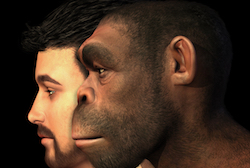Development of height and weight in our early ancestors stand witness to the challenges they faced
Humans as a species are clearly varied but at the same time they are genetically very similar. Understanding the mechanisms which drive this variation remains one of the significant challenges in anthropology. Support to research done through the ADAPT project is helping to explain one key variable – stature and body mass. As part of one of the largest studies of hominin body sizes, researchers have analysed 254 body mass and 204 stature estimates using 311 specimens dating from earliest upright species of 4.4m years ago, right through to the modern humans that followed the last ice age. Setting out their findings in a recently published paper, the team explain that body size is one of the most important determinants of the biology of a species, as it correlates with metabolic rate, life history, energetic expenditure, diet, thermoregulation and home range size. So a greater understanding of how heft and stature evolved can shine a light on a variety of aspects to do with how we became the species we are today. The team established that height and weight in homin species evolved roughly in concert in early specimens, but that around 1.5 million years ago, bulk and stature stopped developing at the same rate. At that point in time hominins grew roughly 10cm taller but would not consistently gain any heft for a further million years, with an average increase of 10-15kgs occurring around 500 000 years ago. The study found body size to be highly variable during earlier hominin history, with a range of differently shaped species: from broad, gorilla-like Paranthropus to the more wiry Australopithecus afarensis. Hominins from four million years ago weighed a rough average of 25kg and stood at 125-130cm. Three clear ‘pulses’ of change Research has established physicality shifts and changes over deep time evolving to a larger body size. But the team found these changes were more dramatic during three periods of significant change. The first marks the dawn of the emergence of Homo, around 2.2-1.9 million years ago, where there is a surge in both height and weight by around 20cms and between 15-20kg. The emergence of Homo erectus marks the next shift in which stature and heft stop developing at the same rate: between 1.4-1.6m years ago early humans grew taller, by 10cm, but body mass developed more slowly. It takes a further million years before heavier hominins appear in the fossil record. At this point they are 10-15kg heavier, indicating their adaptation to the environments north of the Mediterranean. There are, however, a couple of exceptions: Homo naledi and Homo floresiensis. Recently discovered remains suggest these species swam against the tide of increasing body size through time. A clearer idea of the pressures faced by our earliest ancestors This staggering in the development of heft and stature can help us to understand the environmental constraints the early Homo species had to overcome. Lead author, Dr Manuel Will from Cambridge’s Department of Archaeology, and a Research Fellow at Gonville and Caius College, explains what may have caused the pulses of change and periods of stasis. ‘An increase solely in stature would have created a leaner physique, with long legs and narrow hips and shoulders. This may have been an adaptation to new environments and endurance hunting, as early Homo species left the forests and moved on to more arid African savannahs,’ he says. He explains that the higher surface-to-volume ratio of a tall, slender body would be an advantage when stalking animals for hours in the dry heat, as a larger skin area increases the capacity for the evaporation of sweat. ‘The later addition of body mass coincides with ever-increasing migrations into higher latitudes, where a bulkier body would be better suited for thermoregulation in colder Eurasian climates,' Dr Will adds. The ADAPT (Adaptation, Dispersals and Phenotype: understanding the roles of climate, natural selection and energetics in shaping global hunter-gatherer adaptability) project is aiming to overcome the lack of sufficient understanding of the underlying mechanisms needed to adequately interpret the archaeological record. The project will provide the first links between prehistoric hunter-gatherer variation and the evolutionary parameters of life history and energetics that may have shaped our success as a species. For more information, please see: CORDIS project website
Countries
United Kingdom



